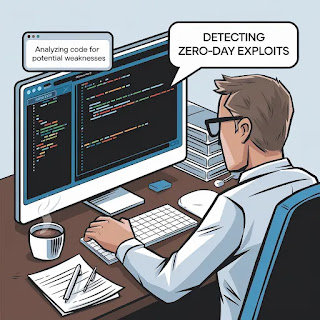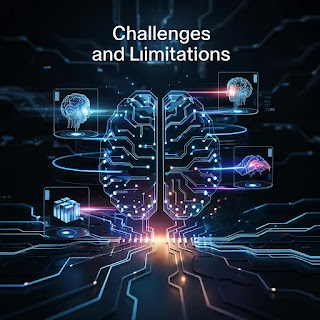The Role of AI in Cybersecurity: Threat Detection and Response.
Introduction: The Growing Cybersecurity Challenge.
Cyber threats are evolving faster
than ever. Hackers are using sophisticated techniques—ransomware, zero-day
exploits, AI-powered attacks—to breach systems, steal data, and disrupt
operations. Traditional security measures, while still necessary, often struggle
to keep up.
This is where Artificial
Intelligence (AI) steps in. AI is transforming cybersecurity by enhancing
threat detection, automating responses, and predicting attacks before they
happen. But how exactly does AI improve security? What are its strengths, and
where does it fall short?
In this article, we’ll explore:
How AI detects cyber threats in real time?
The ways AI automates and accelerates incident response
Real-world examples of AI in action
The challenges and limitations of AI in cybersecurity
What the future holds for AI-driven security?
Let’s dive in.
1.
How AI Enhances Threat Detection
A. Recognizing Patterns and Anomalies
Traditional security tools rely
on predefined rules (like antivirus signatures) to detect threats. The problem?
Hackers constantly change their tactics, making rule-based systems ineffective
against new attacks.
AI, particularly machine learning
(ML), learns from vast amounts of data to identify unusual behavior. For
example:
·
User
Behavior Analytics (UBA): AI monitors login times, locations, and access
patterns. If an employee’s account suddenly starts downloading huge files at 3
AM, AI flags it as suspicious.
·
Network
Traffic Analysis: AI detects unusual data flows, such as a sudden spike in
outbound traffic (a sign of data exfiltration).
Case Study: Darktrace, an AI cybersecurity firm, uses self-learning
algorithms to detect insider threats. In one instance, their AI identified a
rogue employee stealing data by recognizing subtle deviations in normal network
activity—something traditional tools missed.
B. Detecting Zero-Day Exploits
Zero-day attacks exploit unknown
vulnerabilities, making them hard to catch. AI helps by:
·
Analyzing code for potential weaknesses
·
Comparing new threats with past attack patterns
·
Using predictive models to anticipate exploits
Example: In 2020, an AI system at a financial institution detected
a zero-day attack by correlating unusual database queries with known attack
behaviors, stopping the breach before damage occurred.
C. Phishing and Fraud
Prevention
· AI-powered email filters (like those in Microsoft Defender and Google’s Gmail) analyze:
·
Language patterns (urgent, threatening, or
poorly written messages)
·
Sender reputation
·
Embedded links and attachments
Stat: Google’s AI blocks 100 million phishing emails daily, with a
99.9% accuracy rate.
2.
AI in Incident Response: Speed and Automation
Detecting threats is only half
the battle—responding quickly is critical. AI helps by:
A. Automating Threat
Containment
·
Isolating infected devices to prevent malware
spread
·
Revoking access for compromised accounts
·
Blocking malicious IPs in real time
Example: When the WannaCry ransomware hit in 2017, companies using AI-driven security automatically quarantined affected systems, limiting damage.
B. Reducing False
Positives
·
Security teams waste time investigating false alarms.
AI improves accuracy by:
·
Cross-referencing alerts with historical data
·
Prioritizing genuine threats
Stat: IBM’s AI-powered Watson for Cybersecurity reduces false
positives by 85%, allowing analysts to focus on real risks.
C. Predictive Threat Hunting
Instead of waiting for attacks,
AI proactively hunts for threats by:
·
Scanning dark web forums for leaked credentials
·
Simulating attack scenarios to find weak points
Case Study:
PayPal uses AI to scan underground markets for stolen accounts, preventing fraud
before it happens.
3.
Challenges and Limitations of AI in Cybersecurity
While AI is powerful, it’s not a
silver bullet. Key challenges include:
A. Adversarial AI (AI
vs. AI Attacks)
Hackers now use AI to:
·
Generate deepfake phishing voices
·
Evade detection by mimicking normal behavior
· Poison AI models with misleading data
Example: In 2019, researchers demonstrated how AI could trick
facial recognition systems by subtly altering images.
B. Bias and
Over-Reliance on AI
·
If trained on biased data, AI may overlook
certain threats.
·
Over-dependence on AI can make teams complacent.
C. High Costs and
Complexity
·
Implementing AI requires expertise and
investment.
·
Smaller businesses may struggle to adopt
advanced AI solutions.
4.
The Future of AI in Cybersecurity
AI will continue to evolve, with trends like:
·
AI-powered deception tech (fake networks that
lure hackers)
·
Quantum AI for unbreakable encryption
·
Collaborative AI systems where multiple AIs
share threat intelligence
Expert Insight: According to Gartner, by 2025, 60% of enterprises
will use AI for threat detection, up from just 15% in 2020.
Conclusion: AI as a Force Multiplier in
Cybersecurity
AI isn’t replacing human
cybersecurity experts—it’s empowering them. By automating detection, speeding
up response times, and predicting threats, AI acts as a force multiplier in the
fight against cybercrime.
However, it’s not foolproof.
Organizations must combine AI with human expertise, regular updates, and
layered security strategies.
The future of cybersecurity is
AI-augmented defense—where machines and humans work together to stay one step
ahead of attackers.
Final Thought: As
cyber threats grow smarter, so must our defenses. AI is the game-changer we
need—but only if we use it wisely.
What do you think? Is AI the ultimate cybersecurity solution, or does it introduce new risks? Let’s discuss in the comments! 🚀






